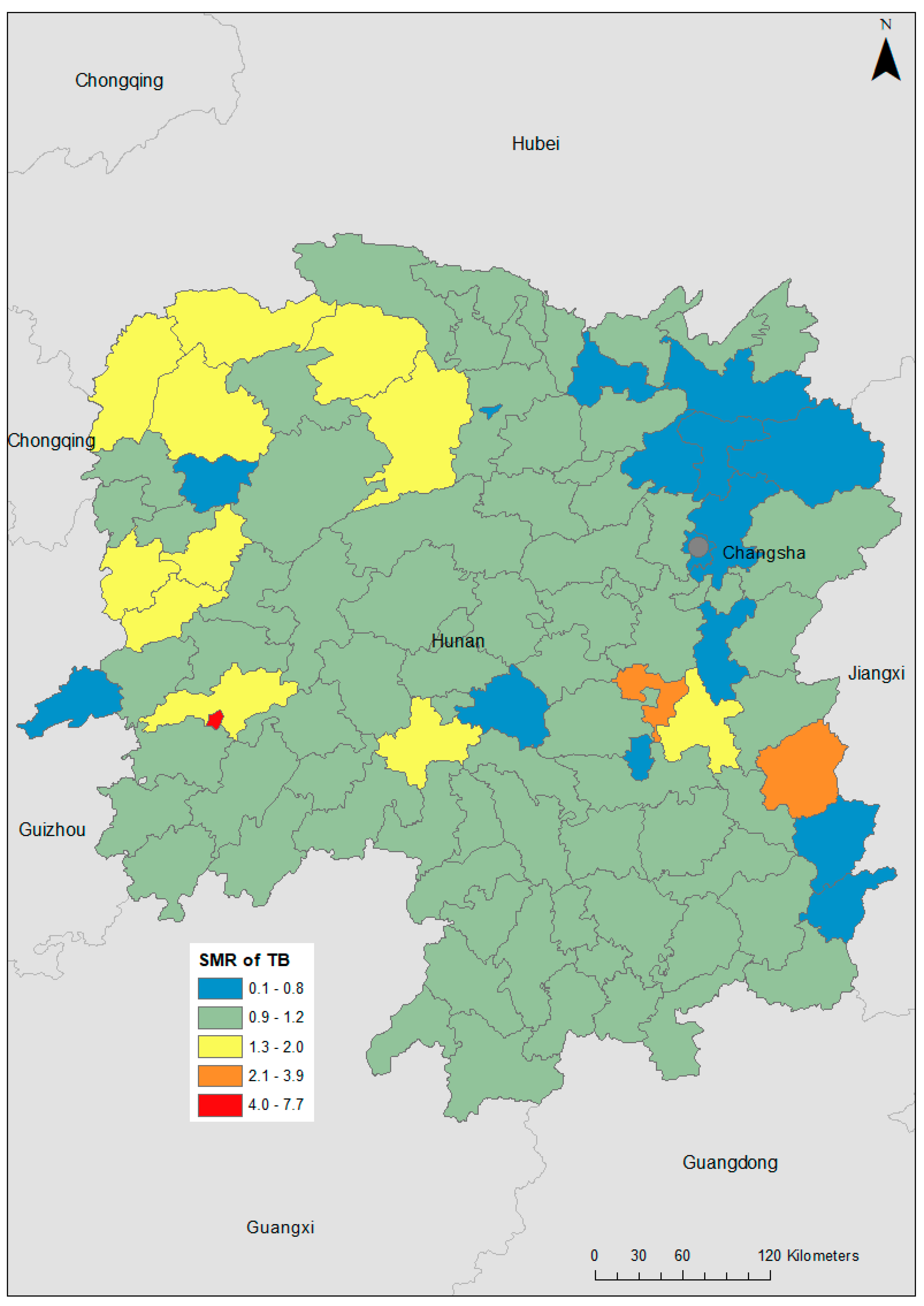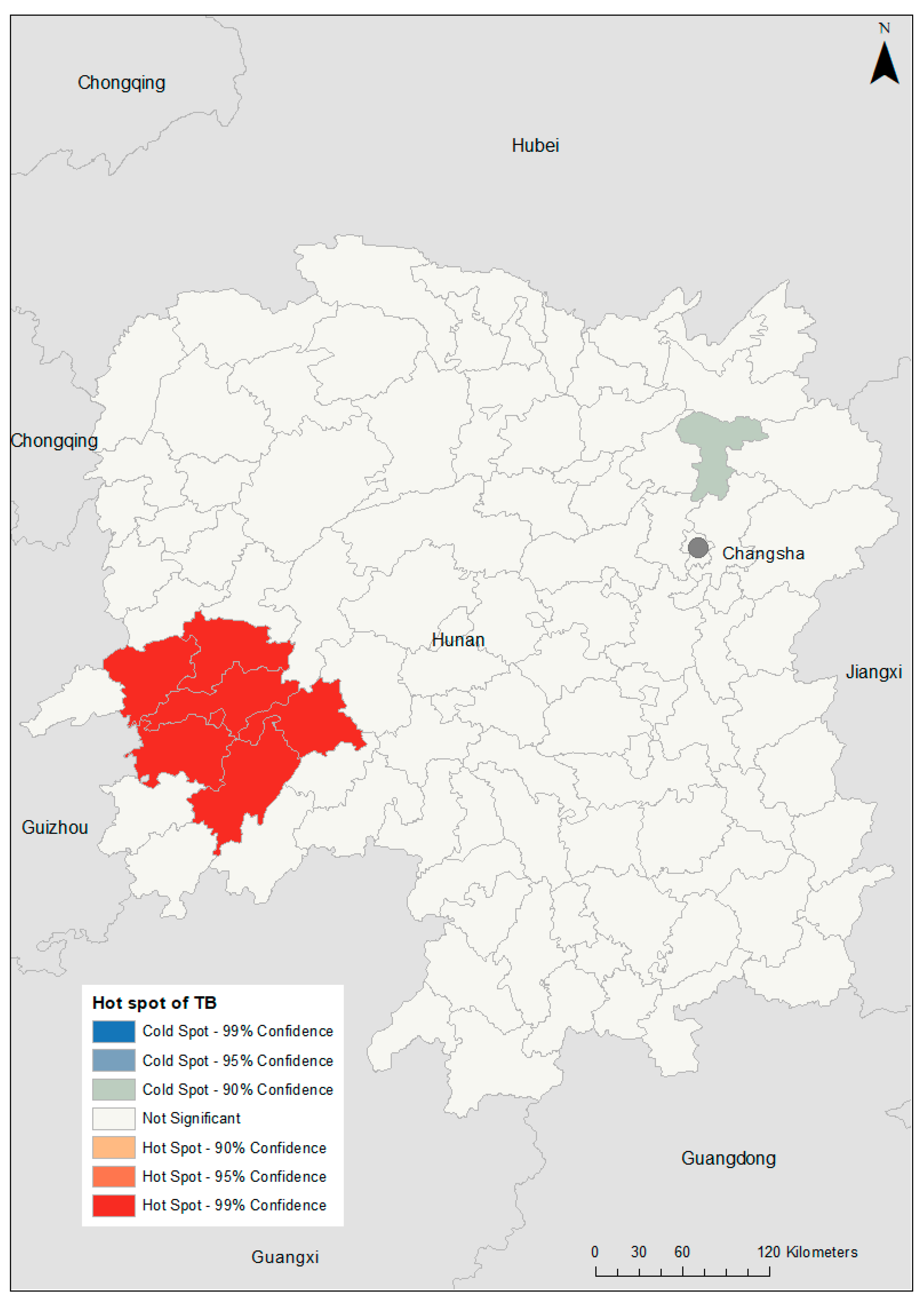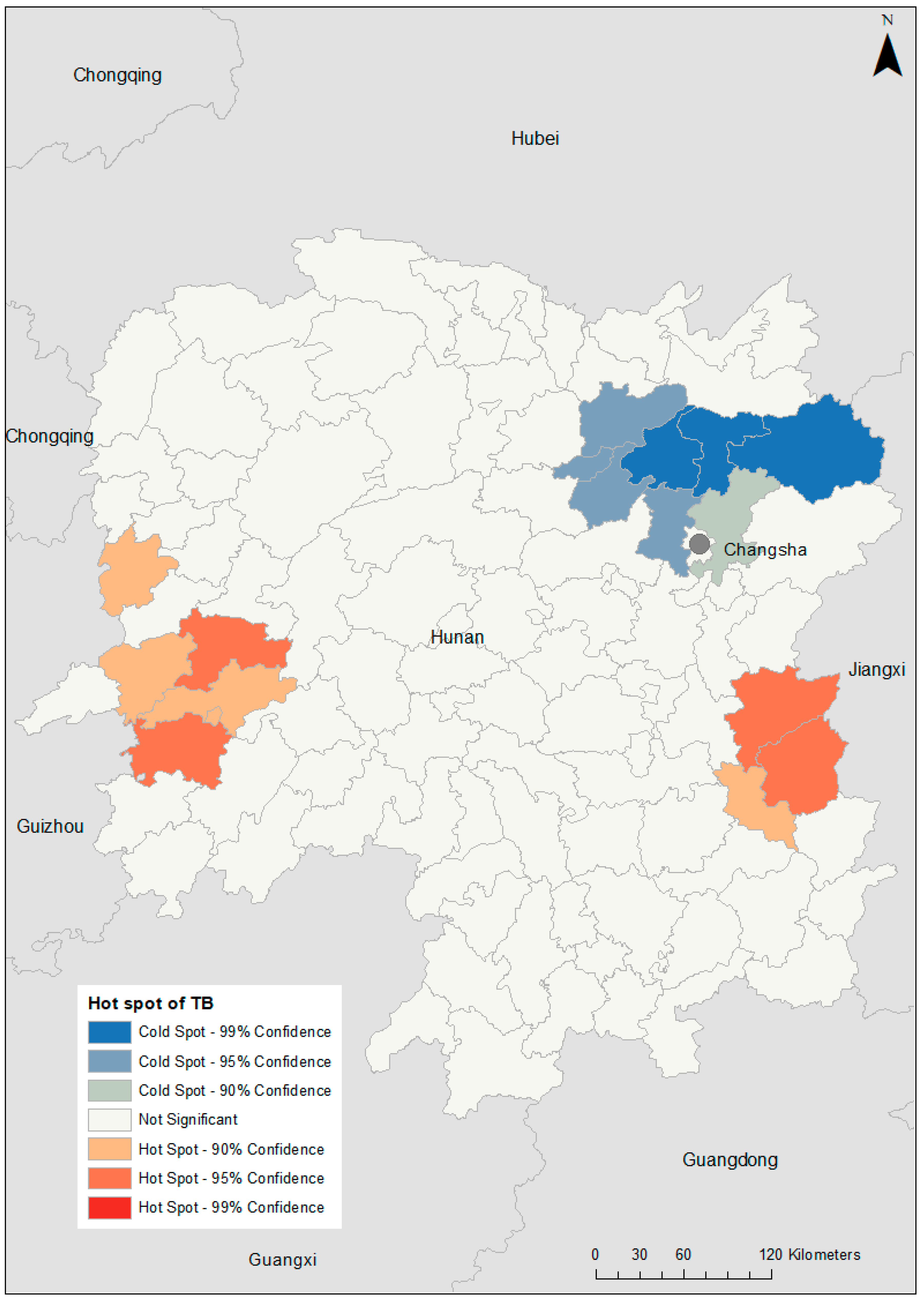Spatiotemporal Patterns of Tuberculosis in Hunan Province, China
Abstract
:1. Background
2. Methods
2.1. Study Area
2.2. Data Sources
2.3. Data Analysis
2.4. Ethical Clearance
3. Results
3.1. Demographic Characteristics of Tuberculosis
3.2. Clinical Characteristics of Tuberculosis
3.3. Temporal Trends of Tuberculosis Incidence
3.4. Spatial Clustering of Tuberculosis
3.5. Factors Associated with Spatial Clustering of Tuberculosis
4. Discussion
5. Conclusions
Supplementary Materials
Author Contributions
Funding
Institutional Review Board Statement
Informed Consent Statement
Data Availability Statement
Conflicts of Interest
Abbreviations
References
- Daniel, T.M. The history of tuberculosis. Respir. Med. 2006, 100, 1862–1870. [Google Scholar] [CrossRef] [Green Version]
- Hayman, J. Mycobacterium ulcerans: An infection from Jurassic time? Lancet 1984, 324, 1015–1016. [Google Scholar] [CrossRef]
- Sia, I.G.; Wieland, M.L. Current concepts in the management of tuberculosis. In Mayo Clinic Proceedings; Elsevier: Amsterdam, The Netherlands, 2011; pp. 348–361. [Google Scholar]
- Paulson, T. Epidemiology: A mortal foe. Nature 2013, 502, S2–S3. [Google Scholar] [CrossRef] [PubMed]
- Roth, G.A.; Abate, D.; Abate, K.H.; Abay, S.M.; Abbafati, C.; Abbasi, N.; Abbastabar, H.; Abd-Allah, F.; Abdela, J.; Abdelalim, A. Global, regional, and national age-sex-specific mortality for 282 causes of death in 195 countries and territories, 1980–2017: A systematic analysis for the Global Burden of Disease Study 2017. Lancet 2018, 392, 1736–1788. [Google Scholar] [CrossRef] [Green Version]
- WHO. Global Tuberculosis Report 2020; World Health Organization: Geneva, Switzerland, 2020. [Google Scholar]
- WHO. Use of High Burden Country Lists for TB by WHO in the Post-2015 Era; World Health Organization: Geneva, Switzerland, 2015. [Google Scholar]
- WHO. Global Tuberculosis Report 2015; WHO: Geneva, Switzerland, 2015. [Google Scholar]
- WHO. Gear up to end TB: Introducing the end TB Strategy; World Health Organization: Geneva, Switzerland, 2015. [Google Scholar]
- WHO. Global Tuberculosis Report 2018; World Health Organization: Geneva, Switzerland, 2018. [Google Scholar]
- Alene, K.A.; Viney, K.; McBryde, E.S.; Clements, A.C. Spatiotemporal transmission and socio-climatic factors related to paediatric tuberculosis in north-western Ethiopia. Geospat. Health 2017, 12, 575. [Google Scholar] [CrossRef] [PubMed]
- Alene, K.A.; Viney, K.; McBryde, E.S.; Clements, A.C. Spatial patterns of multidrug resistant tuberculosis and relationships to socio-economic, demographic and household factors in northwest Ethiopia. PLoS ONE 2017, 12, e0171800. [Google Scholar] [CrossRef]
- Liu, M.-Y.; Li, Q.-H.; Zhang, Y.-J.; Ma, Y.; Liu, Y.; Feng, W.; Hou, C.-B.; Amsalu, E.; Li, X.; Wang, W. Spatial and temporal clustering analysis of tuberculosis in the mainland of China at the prefecture level, 2005–2015. Infect. Dis. Poverty 2018, 7, 106. [Google Scholar] [CrossRef] [Green Version]
- Wang, T.; Xue, F.; Chen, Y.; Ma, Y.; Liu, Y. The spatial epidemiology of tuberculosis in Linyi City, China, 2005–2010. BMC Public Health 2012, 12, 885. [Google Scholar] [CrossRef] [Green Version]
- Zhang, Y.; Wang, X. TB Strikes Another School in Hunan. Available online: https://www.chinadaily.com.cn/china/2017-11/21/content_34799089.htm (accessed on 22 June 2021).
- Hunan Bureau of Statistics. Hunan Province Statistical Communique for the 2018 National Economic and Social Development; Hunan Bureau of Statistics: Hunan, China, 2019. [Google Scholar]
- CIESIN. Gridded Population of the World; CIESIN, Columbia University: New York, NY, USA, 2018. [Google Scholar]
- Fan, J.; Rao, H.; Wu, P.; Zhang, J.; Wu, Y.; Pan, J.; Li, W.; Qiu, L. Analysis on spatial distribution of tuberculosis in China, 2012-2014. Zhonghua Liu Xing Bing Xue Za Zhi = Zhonghua Liuxingbingxue Zazhi 2017, 38, 926–930. [Google Scholar]
- Alene, K.A.; Xu, Z.; Bai, L.; Yi, H.; Tan, Y.; Gray, D.; Viney, K.; Clements, A.C. Spatial clustering of drug-resistant tuberculosis in Hunan province, China: An ecological study. BMJ Open 2021, 11, e043685. [Google Scholar] [CrossRef]
- Carrasco-Escobar, G.; Schwalb, A.; Tello-Lizarraga, K.; Vega-Guerovich, P.; Ugarte-Gil, C. Spatio-temporal co-occurrence of hotspots of tuberculosis, poverty and air pollution in Lima, Peru. Infect. Dis. Poverty 2020, 9, 1–6. [Google Scholar] [CrossRef] [Green Version]
- Alene, K.A.; Clements, A.C. Spatial clustering of notified tuberculosis in Ethiopia: A nationwide study. PLoS ONE 2019, 14, e0221027. [Google Scholar] [CrossRef] [Green Version]
- Alene, K.A.; Wagaw, Z.A.; Clements, A.C. Mapping tuberculosis prevalence in Ethiopia: Protocol for a geospatial meta-analysis. BMJ Open 2020, 10, e034704. [Google Scholar] [CrossRef]
- Tiwari, N.; Kandpal, V.; Tewari, A.; Rao, K.R.M.; Tolia, V. Investigation of tuberculosis clusters in Dehradun city of India. Asian Pac. J. Trop. Med. 2010, 3, 486–490. [Google Scholar] [CrossRef] [Green Version]
- Shaweno, D.; Trauer, J.M.; Denholm, J.T.; McBryde, E.S. The role of geospatial hotspots in the spatial spread of tuberculosis in rural Ethiopia: A mathematical model. R. Soc. Open Sci. 2018, 5, 180887. [Google Scholar] [CrossRef] [Green Version]
- Sita-Lumsden, A.; Lapthorn, G.; Swaminathan, R.; Milburn, H.J. Reactivation of tuberculosis and vitamin D deficiency: The contribution of diet and exposure to sunlight. Thorax 2007, 62, 1003–1007. [Google Scholar] [CrossRef] [PubMed] [Green Version]
- Koh, G.C.; Hawthorne, G.; Turner, A.M.; Kunst, H.; Dedicoat, M. Tuberculosis incidence correlates with sunshine: An ecological 28-year time series study. PLoS ONE 2013, 8, e57752. [Google Scholar] [CrossRef] [PubMed] [Green Version]
- Alene, K.A. Consistent condom use among sexually active HIV-positive women in Amhara region, Ethiopia. Open Access J. Contracept. 2014, 5, 85–90. [Google Scholar] [CrossRef] [Green Version]
- Alene, K.A.; Atalell, K.A. Contraceptive use and method preference among HIV-positive women in Amhara region, Ethiopia. BMC Women’s Health 2018, 18, 1–9. [Google Scholar] [CrossRef] [PubMed] [Green Version]
- Alene, K.A.; Viney, K.; Moore, H.C.; Wagaw, M.; Clements, A.C. Spatial patterns of tuberculosis and HIV co-infection in Ethiopia. PLoS ONE 2019, 14, e0226127. [Google Scholar] [CrossRef] [PubMed] [Green Version]
- Alene, K.A.; Viney, K.; Gray, D.J.; McBryde, E.S.; Wagnew, M.; Clements, A.C. Mapping tuberculosis treatment outcomes in Ethiopia. BMC Infect. Dis. 2019, 19, 474. [Google Scholar] [CrossRef] [PubMed] [Green Version]
- Huang, L.; Abe, E.M.; Li, X.-X.; Bergquist, R.; Xu, L.; Xue, J.-B.; Ruan, Y.; Cao, C.-L.; Li, S.-Z. Space-time clustering and associated risk factors of pulmonary tuberculosis in southwest China. Infect. Dis. Poverty 2018, 7, 91. [Google Scholar] [CrossRef] [PubMed]




| Variables | Number (Percent) |
|---|---|
| Mean age (standard deviation) | 51.7 (17.6) |
| Sex | |
| Male | 234,682 (72.61) |
| Female | 88,524 (27.39) |
| Occupation | |
| Farmer | 251,586 (77.81) |
| Government employee | 6167 (1.91) |
| Non-government employee | 5041 (1.56) |
| Laborer | 10,713 (3.31) |
| Retired | 12,953 (4.01) |
| Student | 9421 (2.91) |
| Unemployed | 18,553 (5.74) |
| Unknown | 4819 (1.49) |
| Others | 4087 (1.26) |
| Year | |
| 2013 | 57,890 (17.9) |
| 2014 | 56,720 (17.54) |
| 2015 | 55,855 (17.27) |
| 2016 | 50,754 (15.7) |
| 2017 | 50,088 (15.49) |
| 2018 | 52,033 (16.09) |
| Patient sources | |
| Contact check | 384 (0.12) |
| Recommended due to symptoms | 4641 (1.44) |
| Referral | 104,906 (32.44) |
| Seek medical treatment | 114,731 (35.48) |
| Health examination | 3206 (0.99) |
| Track | 94,111 (29.11) |
| Other | 1361 (0.42) |
| Type of tuberculosis | |
| Pulmonary tuberculosis | 315,350 (97.53) |
| Extra pulmonary tuberculosis | 7990 (2.47) |
| Treatment outcome | |
| Treatment completed | 193,125 (60.38) |
| Cure | 113,106 (35.36) |
| Failure | 6679 (2.09) |
| Lost to follow-up | 1020 (0.32) |
| Death | 3188 (1.00) |
| Other | 2836 (0.89) |
| Variables | Coefficient (95% CI *) | p-Value |
|---|---|---|
| Socioeconomic and demographic factors | ||
| Proportion of males in a county | −0.12 (−0.27, 0.04) | 0.13 |
| Percentage of urban residents in the counties | 0.29 (0.06, 0.52) | 0.01 |
| Gross domestic product of the county | −0.25 (−0.45, −0.06) | 0.01 |
| Birth rate in the county | −0.17 (−0.35, 0.01) | 0.06 |
| Death rate in the county | −0.12 (−0.35, 0.12) | 0.34 |
| Health care access | ||
| Contraceptive use rate of the county | −0.33 (−0.48, −0.17) | <0.001 |
| Number of institutions per 10,000 population in a county | 0.05 (−0.16, 0.26) | 0.64 |
| Number of hospital beds per 10,000 population in a county | −0.36 (−0.81, 0.09) | 0.11 |
| Number of medical personnel per 10,000 population in county | 0.26 (−0.25, 0.77) | 0.32 |
| Climatic factors | ||
| Monthly average temperature | 0.06 (−0.10, 0.22) | 0.49 |
| Annual total precipitation | −0.07 (−0.26, 0.12) | 0.46 |
| Monthly sunshine hours | −0.09(−0.10, −0.08) | <0.001 |
| Variables | Spatially Unstructured Model | Spatially Structured Model | Both Spatially Structured and Unstructured Model |
|---|---|---|---|
| (RR (95% CrI) | (RR (95% CrI) | (RR (95% CrI) | |
| Socioeconomic and demographic factors | |||
| Proportion of males in a county | 0.96 (0.87, 1.06) | 0.97 (0.85, 1.09) | 0.96 (0.87, 1.07) |
| Percentage of urban residents in the counties | 1.09 (0.96, 1.23) | 1.04 (0.93, 1.15) | 1.07 (0.95, 1.22) |
| Gross domestic product of the county | 0.88 (0.77, 1.00) | 0.94 (0.84, 1.05) | 0.91 (0.80, 1.03) |
| Birth rate in the county | 0.94 (0.84, 1.06) | 0.96 (0.83, 1.09) | 0.95 (0.84, 1.08) |
| Health care access | |||
| Prevalence of contraceptive use | 0.87 (0.78, 0.96) | 0.91 (0.81, 1.01) | 0.88 (0.79, 0.98) |
| Number of hospital beds per 10,000 population in a county | 0.98 (0.87, 1.10) | 0.99 (0.90, 1.10) | 0.99 (0.88, 1.10) |
| Climatic factors | |||
| Monthly sunshine hours | 0.86 (0.78, 0.96) | 0.84 (0.70, 1.00) | 0.86 (0.74, 0.97) |
| Temporal trend (by quarter) | 0.61 (0.51, 0.72) | 0.63 (0.54, 0.82) | |
| Heterogenicity | |||
| Variance of spatially unstructured random effect (σ2) | 0.46 (0.40, 0.53) | 0.39 (0.09, 0.51) | |
| Variance of spatially structured random effect (σ2) | 0.95 (0.82, 1.10) | 0.36 (0.03, 0.95) | |
| Intercept (alpha) | −0.002 (−0.09, 0.09) | −0.01 (−0.02, 0.01) | −0.003 (−0.09, 0.08) |
| DIC | 1217.0 | 816.0 | 643.0 |
Publisher’s Note: MDPI stays neutral with regard to jurisdictional claims in published maps and institutional affiliations. |
© 2021 by the authors. Licensee MDPI, Basel, Switzerland. This article is an open access article distributed under the terms and conditions of the Creative Commons Attribution (CC BY) license (https://creativecommons.org/licenses/by/4.0/).
Share and Cite
Alene, K.A.; Xu, Z.; Bai, L.; Yi, H.; Tan, Y.; Gray, D.J.; Viney, K.; Clements, A.C.A. Spatiotemporal Patterns of Tuberculosis in Hunan Province, China. Int. J. Environ. Res. Public Health 2021, 18, 6778. https://doi.org/10.3390/ijerph18136778
Alene KA, Xu Z, Bai L, Yi H, Tan Y, Gray DJ, Viney K, Clements ACA. Spatiotemporal Patterns of Tuberculosis in Hunan Province, China. International Journal of Environmental Research and Public Health. 2021; 18(13):6778. https://doi.org/10.3390/ijerph18136778
Chicago/Turabian StyleAlene, Kefyalew Addis, Zuhui Xu, Liqiong Bai, Hengzhong Yi, Yunhong Tan, Darren J. Gray, Kerri Viney, and Archie C. A. Clements. 2021. "Spatiotemporal Patterns of Tuberculosis in Hunan Province, China" International Journal of Environmental Research and Public Health 18, no. 13: 6778. https://doi.org/10.3390/ijerph18136778
APA StyleAlene, K. A., Xu, Z., Bai, L., Yi, H., Tan, Y., Gray, D. J., Viney, K., & Clements, A. C. A. (2021). Spatiotemporal Patterns of Tuberculosis in Hunan Province, China. International Journal of Environmental Research and Public Health, 18(13), 6778. https://doi.org/10.3390/ijerph18136778








